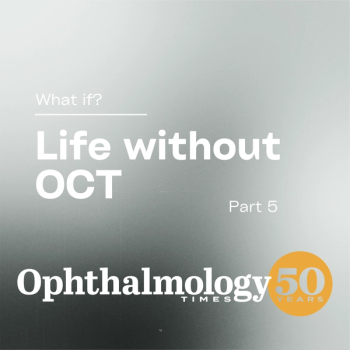
Switching treatments for wet AMD poses numerous complexities
Studies that focus on switching treatments for exudative age-related macular degeneration may represent more real-life scenarios. However, future prospective studies with predetermined switching criteria and follow-up are needed.
Take-home message: Studies that focus on switching treatments for exudative age-related macular degeneration may represent more real-life scenarios. However, future prospective studies with predetermined switching criteria and follow-up are needed.
By Vanessa Caceres; Reviewed by Rishi Singh, MD
Cleveland-Switching treatment is not uncommon in medicine. In fact, a number of studies with patients who have rheumatoid arthritis or multiple sclerosis have found benefits from switching.
Yet, just how effective is switching medications for patients with exudative
Why make the change?
How insufficient response is defined is “debatable,” said Rishi Singh, MD, staff physician, Cole Eye Institute, Cleveland Clinic, and assistant professor of ophthalmology, Case Western Reserve University, Cleveland.
Insufficient response could be defined by persistence of fluid on optical coherence tomography (OCT), lack of flattening of the pigment epithelial detachment, and the requirement of continued re-treatment.
However, a number of OCT results from randomized, controlled trials show persistent fluid in patients, even after 1 year of treatment, Dr. Singh said.
“It approaches 50% or greater in a number of studies,” he said. “Using this as a definition may not be the best entry point.”
Regarding tachyphylaxis, Dr. Singh cited a 2012 study in the British Journal of Ophthalmology that found switching between
He also mentioned the SEVEN-UP Study, which had 7 years of follow up and included 65 patients from the ANCHOR, MARINA, and HORIZON trials.2 In that study, there was initial improvement but a subsequent mean visual decline of almost 8.6 letters from baseline.
“Is this just the treatment they were assigned to or tachyphylaxis over that course of treatment?” Dr. Singh said.
When considering a switch because clinical trial data lack real-life application, Dr. Singh said that retina specialists most often choose a treat-and-extend approach even though there is a lack of randomized trials that support the efficacy of this. Most specialists choose monthly dosing in a minority of cases.
“These trends reflect the inability to adopt monthly dosing,” he said.
The idea of switching therapies to reduce the frequency of dosing is the “holy grail-what we all hope for our patients,” Dr. Singh said.
Some research points to a value of this approach, he added.
ASSESS Study
These various considerations led Dr. Singh and fellow investigators to conduct the ASSESS Study-short for “A Single Arm, Investigator Initiated Observational Study of the Efficacy, Safety, and Tolerability of Intravitreal Aflibercept Injection in Subjects with Exudative Age Related Macular Degeneration Previously Treated with Ranibizumab or Bevacizumab.”
The 26 enrolled patients had subfoveal choroidal neovascularization secondary to exudative AMD, one or more injections of ranibizumab or bevacizumab within 3 months of enrollment for active exudative AMD, an ETDRS vision of 20/25 to 20/320, and presence of fluid by OCT or presence of a new hemorrhage by clinical exam.
Patients received three upfront injections of aflibercept (Eylea, Regeneron) followed by Q2 month injections thereafter.
Patients were re-treated if any of the following occurred 30 days since the last treatment:
- Loss of 10 or more ETDRS letters from the best previous measurement,
- A 75-µm increase in retinal thickness, and
- The presence of new subretinal hemorrhage by clinical exam.
Patients in the study had a mean of 9.62 injections before the study, with a range of 3 to 23 injections. The mean central retina thickness was 304.08 µm.
At the end of the study, the average number of aflibercept injections was 9.6. There was a mean 9.4 letter visual gain and an overall reduction in central retina thickness.
Dr. Singh concluded that it is challenging to interpret the results of switching studies, and that most of these studies are conducted because of the reasons he outlined.
Although some rationales for these studies may not be valid in light of evaluation of clinical trial data, the studies can evaluate a patient population that may not be included within a clinical trial and may represent more real-life scenarios, he said.
“Future prospective studies with predetermined switching criteria and follow-up are recommended to fully explore the impact of switching anti-VEGF therapy,” he said.
References
1. Gasperini JL, Fawzi AA, Khondkaryan A, et al. Bevacizumab and ranibizumab tachyphylaxis in the treatment of choroidal neovascularisation.
2. Bhisitkul RB, Mendes TS, Rofagha S, et al. Macular atrophy progression and 7-year vision outcomes in subjects from the ANCHOR, MARINA and HORIZON studies (SEVEN-UP Study).
Rishi Singh, MD
This article was adapted from Dr. Singh’s presentation at Retina Subspecialty Day at the 2014 meeting of the American Academy of Ophthalmology. Dr. Singh did not indicate any proprietary interest in the subject matter.
Newsletter
Don’t miss out—get Ophthalmology Times updates on the latest clinical advancements and expert interviews, straight to your inbox.


















































.png)


